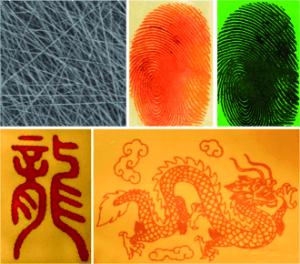 |
An electrospun nanofiber mat is used to identify latent fingerprints on various surfaces within 30 seconds and produce inkjet-printed patterns. In contrast to classical approaches, the method is easy-to-operate, environmentally friendly, and has implications in other applied systems including chemical sensors, drug delivery, biological detection, and microreactors.
[Credit: Angewandte Chemie, DOI 10.1002/anie.201006537] |
When we touch a surface, tiny traces of perspiration and oils stay behind, mirroring the ridge patterns on our fingertips. There are now a number of different methods to make these latent fingerprints visible. The new method is significantly faster than the classic technique of dusting with powder. Unlike spectroscopic methods, it does not require complex technical instruments, and problematic chemicals like ninydrin are not needed either. In addition, it is suitable for all types of surfaces: by lightly pressing the mat onto the surface, the researchers were able to reliably transfer fingerprints from a wide variety of materials, including steel, quartz, glass, plastic, marble, and wood.
The secret of their success is the special mat, a fleece made from nanofibers of thermoplastic polyurethane and fluorescein, a dye. The mat is made in a process called electrospinning. When the mat comes into contact with a fingerprint, components of the perspiration react with the polyurethane, causing cross-linking of the polymer chains. The hot air accelerates the reaction. In the cross-linked regions, the fluorescein cannot remain within the fibers so it comes out as a powdery solid. However, the dye only fluoresces when it is very finely dispersed in the nanofibers, not when it is in small solid clumps. This causes the color of the mat to change from straw yellow to red, making the fingerprint visible within 30 seconds in daylight. The method only works with nanofibers, because only they have enough surface area to produce a visible reaction.
The mat can identify more than mere fingerprints. The researchers were able to “print” an image of a small dragon onto the mat by using an ink-jet printer. Their ink was simply water, which can also cause the cross-linking reaction. The combination of ink-jet printing and the release of a chemical from a nanofiber mat could also be used to produce miniaturized systems such as sensors, microreactors, and diagnostic chips.



